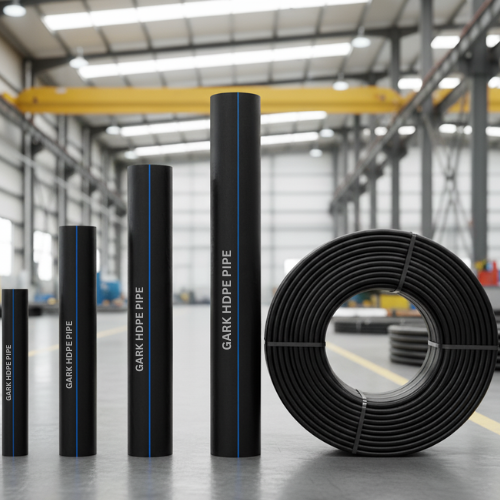Introduction
In today’s infrastructure and construction world, choosing the right piping materials can make or break a project. HDPE (High-Density Polyethylene) pipes are increasingly preferred by pipe buyers, engineers, contractors, and manufacturers alike. At GARK POLYPLAST, we manufacture HDPE pipes built for strength, flexibility, and long life. Whether you’re working on water supply, sewerage, irrigation, or telecom cable systems, knowing what makes HDPE pipes exceptional can help you make smarter decisions—and avoid costly mistakes down the road.
What Are HDPE Pipes?
HDPE pipes are made from high-density polyethylene, a thermoplastic polymer with impressive properties. Unlike traditional materials like steel, cement, or cast iron, HDPE pipes resist corrosion, are lighter, and can tolerate high pressures. They’re available in different pressure grades (e.g. PE-63, PE-80, PE-100) and diameters, making them versatile for both pressure and non-pressure applications.
Market Trends in India (2024-2033)
Understanding market trends can help pipe buyers and manufacturers anticipate demand, plan investments, and pick the right products.
- The Indian HDPE pipes market size was valued at about USD 689.70 million in 2024, and is expected to grow to nearly USD 990.15 million by 2033, with a CAGR of ~4.10%.
- Growth is being driven by major infrastructure programs (e.g. Smart Cities, AMRUT, rural water supply) and government initiatives in irrigation and water management.
- Increasing environmental awareness is pushing demand for recyclable, long-lasting piping materials. HDPE, being lighter, recyclable and low maintenance, gains favor over traditional materials.
- Key challenges include fluctuations in raw material prices (especially polyethylene resin), competition from PVC, metal, and traditional alternatives, and awareness among end-users in remote/rural areas.
How to Choose a Reliable HDPE Pipe Manufacturer
If you’re a buyer or contractor, picking the right manufacturer is crucial. Here’s what to look for:
- Certifications & Standards: Look for IS/BIS standards, ISO certifications, PE grades like PE-80 or PE-100.
- Product Range & Pressure Ratings: Wide variety in diameters, pressure (PN) classes, and special purpose pipes (sprinkler, cable protection etc.).
- Material Quality: Virgin raw materials, UV stabilizers, quality resins.
- Manufacturing Technology: Modern extrusion machines, quality control labs, proper jointing methods (heat fusion).
- After-Sales Support & Warranty: Technical support, timely delivery, reliable supply chain.
Why GARK POLYPLAST is Your Go-To Choice
At GARK POLYPLAST, we understand what pipe buyers need:
- Premium HDPE pipes built with the best raw materials.
- Strong product line including DWC pipes, PLB duct pipes, and sprinkler pipes.
- Over 10 years of consistent production & satisfied clients.
- Certified quality control processes to ensure leak-proof, durable performance.
When you partner with us, you don’t just buy pipes—you invest in reliability, durability, and performance that lasts.
FAQs
Q: What’s the difference between PE-80 and PE-100?
A: They are grades of HDPE resin. PE-100 has higher pressure resistance and strength; PE-80 is good for moderate pressures. Choose based on application.
Q: Are HDPE pipes safe for drinking water?
A: Yes. When manufactured with food-grade virgin resin and following potable water IS/BIS standards, HDPE pipes are non-toxic and safe.
Q: How long do HDPE pipes last under typical conditions?
A: With proper installation, PE-100 HDPE pipes can last for 50 years or more. Maintenance needs are minimal.
Conclusion
HDPE pipes offer a winning combination of durability, flexibility, corrosion resistance, and cost efficiency. Whether for agriculture, water supply, industrial transport, or telecom wiring, these pipes deliver long-term value. For pipe buyers seeking quality, working with a reputable manufacturer like GARK POLYPLAST ensures you get reliable products that suit your application and budget. Reach out today to explore our product range and get expert guidance for your next project.





Leave A Comment